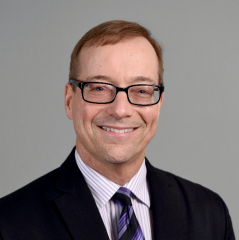Editor's note: This is part of a series investigating gun violence from many angles.
It has become routine.
Reports come in on another mass shooting. This time it’s at a school. A church. A newsroom. Politicians express their deepest sympathies and the grieving public offers their thoughts and prayers.
Then the questions begin. What was the perpetrator’s motive? Should he have had access to guns? Did he have a history of domestic violence or any mental health issues? And the question that begs to be answered most: What can we do to stop this?
Ronald O’Donnell is a clinical professor in Arizona State University’s College of Health Solutions, a psychologist and the founding director of the college’s Doctor of Behavioral Health program. He shared with ASU Now his thoughts on what public policy efforts, in the realm of mental health, could be pursued to encourage a decline in these events.

Ronald O'Donnell
Question: What is the scale of the mental health crisis in this nation? Where have we fallen short in our attention to mental health care?
Answer: There is a tremendous gap between the prevalence and need for mental health services and treatment resources to meet this demand. The 2018 Mental Health in America report that pools national data found that 18 percent, nearly 43 million Americans, have a mental health condition, but fewer than half have received treatment. On average, it takes 10 years between the onset of mental health symptoms and when someone begins receiving treatment.
Among young adults, the extent of the problem is getting worse — rates of severe youth depression have increased over the past five years; half of all youth screened report thinking about suicide or self-harm and over 76 percent of youth with severe depression do not receive treatment. There is a shortage of mental health providers to meet these growing needs.
Q: In your ideal world, what additional policies, laws, services, resources, programs or funding would exist to support access to mental health care, particularly for those who are compelled toward violence?
A: The American Psychological Association (APA) published a report on gun-violence prediction, prevention and policy that found gun violence is a complex, multifaceted problem that requires improvements in four broad areas:
- Evidence-based, in-school violence-prevention programs that include threat assessment.
- Greater research support to develop public health policies such as a federal advisory panel to use scientific evidence to reduce violence, increased funding for research and a national reporting system for gun violence.
- Enhanced access to mental health and the promotion of integrated health care, meaning a behavioral clinician is available in the primary care clinic.
- Community-based initiatives such as policies to reduce access to firearms by at-risk youth, community and school-based threat-assessment programs, and public health campaigns for at-risk individuals and their families.
Q: Many of the recent mass shootings were perpetrated by young men. Does the mental health crisis disproportionately affect this demographic? What services or policies could be enacted to support youth who are struggling?
A: The mental health crisis certainly affects young adults disproportionately, so in that respect the answer is yes. However, research also shows that only 15 to 23 percent of mass shooters had a diagnosed mental health condition.
There are stronger predictors of mass shooting for men. One is domestic violence. Nearly 60 percent of mass-shooting perpetrators included a spouse or other family member among the victims. A sense of grievance by the mass shooter that he has been wronged by an individual or demographic group (women, minorities) is common. Men who commit mass shootings may have failed to achieve romantic or financial success associated with societal expectations for masculinity. A distorted view of masculinity may emphasize expression of aggression by men in response to stressors, and these same views may discourage men from seeking professional help as a sign of weakness or vulnerability. A desire for notoriety is also common among mass shooters.
In terms of services and policies to support struggling youth at risk for gun violence, the APA report recommended that psychologists develop interventions that can change distorted views of masculinity that encourage aggression and violence. There are current programs designed to promote new social perspectives on masculinity. Public health campaigns can encourage help-seeking by distressed young adults. Interventions for at-risk families and prevention require a developmental perspective and help for parents to raise emotionally healthy children and identify those at risk.
Q: What role can the government play in supporting more funding and resources for mental health care? Should the government play the largest role here, or should this be driven by some other segment of society?
A: A recent study in a journal of epidemiology summarized the evidence for firearm legislation in preventing gun violence based on a review of studies worldwide. The researchers studied different types of legislation such as laws on sales and ownership, storage, specific types of firearms and ammunition. This study concluded that laws targeting a combination of firearms restrictions is associated with reduced firearms deaths. Laws that restrict gun purchases such as background checks and limit access such as safer storage of firearms are associated with reduced intimate-partner homicides and unintentional deaths of children by firearms.
The government can play an important role in supporting research by creating a national database for reporting violent death, and additional research on causes and prevention of gun violence. However, current state and federal restrictions limit or discourage research on gun violence.
A prevention and population health approach to gun violence is recommended that includes improved school-based violence-prevention programs. A hallmark of prevention and population health approaches is to engage communities with programs to improve police-community relations, community-based services and local leadership in preventing violence.
Top photo courtesy of Pixabay
More Law, journalism and politics
Can elections results be counted quickly yet reliably?
Election results that are released as quickly as the public demands but are reliable enough to earn wide acceptance may not always be possible.At least that's what a bipartisan panel of elections…
Spring break trip to Hawaiʻi provides insight into Indigenous law
A group of Arizona State University law students spent a week in Hawaiʻi for spring break. And while they did take in some of the sites, sounds and tastes of the tropical destination, the trip…

LA journalists and officials gather to connect and salute fire coverage
Recognition of Los Angeles-area media coverage of the region’s January wildfires was the primary message as hundreds gathered at ASU California Center Broadway for an annual convening of journalists…


